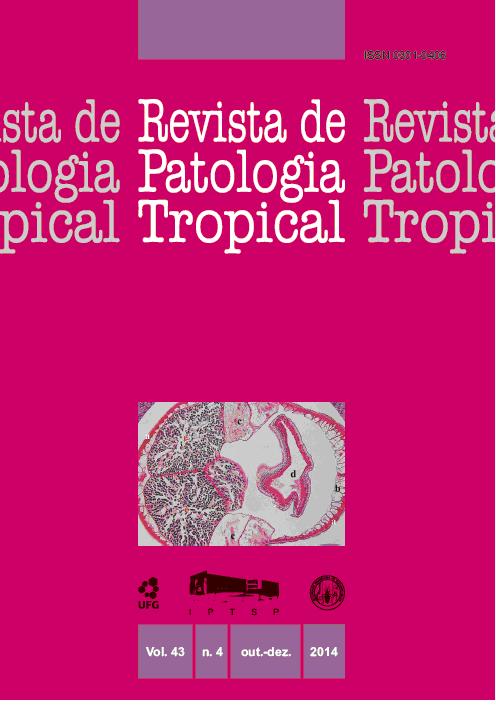EPIDEMIOLOGIA E DISTRIBUIÇÃO DE FLEBOTOMÍNEOS (DÍPTERA: PHLEBOTOMINAE) EM ÁREAS DE TRANSMISSÃO DA LEISHMANIOSE TEGUMENTAR AMERICANA – BLUMENAU-SC, BRASIL.
DOI:
https://doi.org/10.5216/rpt.v43i4.33616Palavras-chave:
Díptera, psychodidae, Leishmania, Blumenau, Vetores.Resumo
Em 2005, 259 casos de leishmaniose tegumentar americana (LTA) foram registrados no municípiode Blumenau, sul do estado de Santa Catarina. Visando à obtenção de maiores informações sobre ociclo de transmissão da doença no município, o objetivo deste estudo foi realizar um levantamentodos pacientes afetados por LTA, avaliar e caracterizar a fauna de flebotomíneos na cidade. Nasresidências com casos confirmados de LTA, aplicou-se um questionário ao paciente ou responsávelcontendo 11 perguntas sobre as condições sanitárias da residência, seu entorno, proximidade dafloresta e presença de animais domésticos e silvestres. As coletas dos flebotomíneos foram realizadasem 14 residências distribuídas em quatro bairros (Badenfurt, Itoupava Central, Velha e Progresso).Os bairros foram escolhidos por apresentarem o maior número de casos da doença. Os insetos foramcoletados durante três noites consecutivas por mês, de abril a outubro de 2008, usando-se armadilhasCDC. Dos domicílios selecionados para a pesquisa, 15 pacientes foram identificados, sendo 53,3%do sexo feminino e 46,6% do sexo masculino. Todas as residências estavam a menos de 200 m dafloresta, 85,7% relataram a presença de animais selvagens perto das casas e 72,2% relataram teralgum animal doméstico. Foram obtidos 175 exemplares de 8 espécies, sendo Nyssomyia neivai(42,9%) e Pintomyia fischeri (38,2%) as prevalentes.Downloads
Downloads
Publicado
Como Citar
Edição
Seção
Licença
The manuscript submission must be accompanied by a letter signed by all authors stating their full name and email address, confirming that the manuscript or part of it has not been published or is under consideration for publication elsewhere, and agreeing to transfer copyright in all media and formats for Journal of Tropical Pathology.

